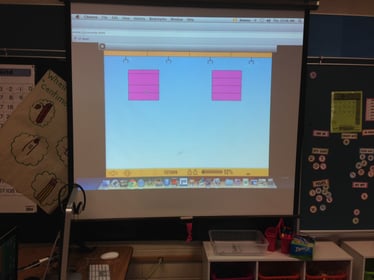
By: Jodie Bailey, Ph. D., Math Bridge Course Instructor for Grade 5, Hilliard City School District
When I first saw ST Math two years ago, I knew it was a powerful tool for instruction that I wanted for our students, teachers, and families. Due to some good fortune, our district has the opportunity to be part of a grant that allows us to provide all K-5 students in our schools with access to ST Math. After the initial training, many of our teachers and students were proficient with logging onto ST Math and having individual students interact with JiJi on an independent basis. We wanted to bring JiJi further into the classroom.
Our building was able to use half-day data team meetings to explore ST Math. We started with the “big picture” by looking at puzzles that aligned with one or two standards currently being taught in the classroom.

Teachers explore how to connect ST Math games to activities in the classroom.
For example, if a third-grade class was beginning an introduction to fractions, the teacher might look at the Equal Areas puzzles in the Explore section of Fraction Concepts. Teachers were asked to think about the vocabulary that might be used in talking about the puzzle. Possible vocabulary words that students might use include equal, equivalent, congruent, same, and identical.
The conversation around these puzzles helps the teacher uncover what students already know about fractional thinking from grade 2 and to begin planning how to introduce the ideas of fractional parts for grade 3.
Thinking about how to engage students in conversations about the mathematics is important. Research suggests that the role of the type of questioning used by teachers is important in the development of student understanding of mathematical ideas (Franke, M.L., Webb, N.M., Chan, A.G., Ing, M., Freund, D., & Battey, D., 2009; Lampert, 1990). Teachers are able to determine more about a student’s thinking by asking a series of probing questions rather than using only a single question.
ST Math Tip: The Facilitating Questions provide a useful beginning for the probing questions a teacher might use to learn more about students’ thinking of the mathematical concepts.
After spending time thinking about how to use ST Math with whole class lessons to introduce or review content, the teachers were asked to consider how they might use the puzzles for small group instruction. The groups receiving the instruction might be identified from the ST Math reports, classroom assessments, or teachers’ observations. The instruction might be to review concepts for students struggling with a mathematical idea or to extend students’ thinking for those in need of a challenge. In the smaller groups the teacher is able to provide more attention to individual student thinking in the small group setting.
Finally, we looked at individual reports and alerts. Setting aside time to discuss and share ideas enabled teachers to support one another with suggestions for addressing specific student frustrations and alerts. Ideas included:
One of the most powerful revelations that came out of our data teams was from our Kindergarten team. At the time of our meetings, our teachers were working on student grade cards. They noticed that two of their students were far ahead in ST Math in comparison to their classmates. However, these students were struggling in the classroom in math due to their limited understanding of the English language.
ST Math provides English Language Learners (ELLs) another way to share their understanding of mathematics. The kindergarten teachers used the data from ST Math to provide feedback to parents in the report card and began to adjust their instruction to incorporate more of the ST Math conversations into their math teaching in the classroom. The success of these ELL students provided a strong motivation for teachers at other grade levels to look more closely at the data of their ELL students and think further about how to shift their instruction. Using our building’s data teams to integrate ST Math helped our teachers strengthen mathematics instruction for all students in our building.
Are you using ST Math in your school? Sign up for an upcoming free webinar and learn how to maximize your students' time with JiJi.
References:
Franke, M.L., Webb, N.M., Chan, A.G., Ing, M., Freund, D., & Battey, D. (2009). Teacher questioning to elicit students’ mathematical thinking in elementary school classrooms. Journal of Teacher Education, 60. Retrieved from http://cotsen.org/wp-content/uploads/2010/08/sagepub.com_-article_Teacher-Questioning.pdf.
Lampert, M. (1990). When the problem is not the question and the solution is not the answer: Mathematical knowing and teaching. American Educational Research Journal, 27(1), 29-63.

MIND Research Institute welcomes guest blogs that highlight best practices in math education, blended learning and innovative learning strategies that inspire students at all ages.
Comment